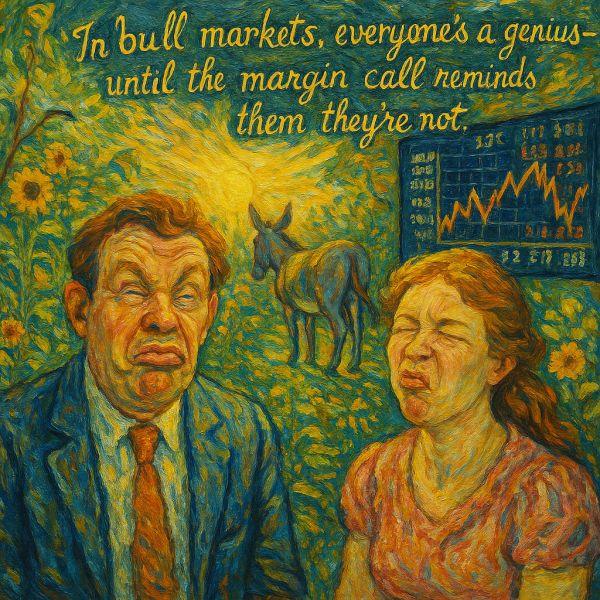Michael Burry Stock Market Crash: Warning Sirens From a Man Trapped in 2008
Dec 09, 2025
He once bet against the world’s confidence — shorted synthetic optimism in the housing-market boom, pocketed a fortune, and drifted from genius to legend. (Investopedia)
But since the fame, the warnings piled up faster than results. Dreams of apocalyptic collapses flashed early. Markets ignored the alarm bells. Liquidity flooded back. Trust rebounded. The crowd leaned in, not out. The real question became not whether Burry was right, but whether being early in a world addicted to delay still counts.
Markets don’t collapse because someone warns. They collapse when the crowd forgets what risk feels like. Then, blood rains. Not before.
Post-2008: When a Prophet’s Echo Becomes White Noise
| Year / Period | Warning / Call by Burry | Outcome / Reality |
|---|---|---|
| 2005-2007 | Predicted subprime mortgage collapse; took massive CDS positions | Housing market crashed in 2007-08; Burry reportedly earned ≈ US$100 M personally, > US$700 M for investors. (Wikipedia) |
| 2010 | Warned of “mutating bubble” due to quantitative easing | Markets rose; liquidity-driven rally persisted; no crash. (Economist Writing Every Day) |
| 2013 | Short on market rally; called bull run “inflated” | Market continued upward trend for years; rally ignored bearish call. (Wikipedia) |
| Dec 2015 | Predicted imminent crash | S&P 500 returned ≈ +11 % over next 12 months. |
| May 2017 | Forecast global economic collapse, even a WW-scale crisis | S&P 500 surged 19 % in the following year. (New Trader U) |
| Sept 2019 | Warned of index-ETF bubble, broad crash risk | Index funds rallied; bulls remained strong. |
| 2020 (COVID crash) | Maintained bearish posture, expecting deeper collapse | Markets rebounded 72 %+ by mid-2021. (Investing.com) |
| Feb 2021 | Declared markets at bubble peak; crash inevitable | S&P 500 rose ~16 % over next 12 months; valuations kept inflating. (Investing.com) |
| 2022-2023 | Predicted further crash, systemic downturn | Markets fluctuated but avoided a crash of expected magnitude. |
| 2025 | Short positions on AI/Tech (e.g., Nvidia, Palantir) again warning of a bubble | As of the last filings, positions disclosed; the broad market remains resilient. (Business Insider) |
Notes:
- Burry’s 2008 call was monumental; after that, his bearish predictions frequently arrived too early or never materialised.
- As of 2025, he closed his hedge fund, citing “valuation mismatch with markets.” (Economist Writing Every Day)
- Many of his 2010–2025 warnings coincided with powerful central-bank interventions, fiscal support, and structural changes that rewrote risk dynamics.
Technical Analysis + Mass Psychology: How to Beat Burry in His Own Game
Michael Burry sees structural rot. Debt, leverage, delusion. His lens is macro and slow. He hunts tectonic shifts, not daily tremors. But markets don’t move in tectonics anymore. They move in crowd pulses. They turn not when a model says so but when belief collapses, and belief collapses only when crowds give up the story they love.
This is where technical analysis and mass psychology fuse into a weapon sharper than any macro doom forecast.
Burry has repeatedly called tops based on fundamentals. But fundamentals don’t create tops by themselves. Crowd euphoria does. And crowd euphoria leaves fingerprints on charts so clean you could cut your teeth on them.
The formula is simple:
Ignore the doomsday prophecy. Track the mood. Watch the chart. Strike when the herd betrays itself.
1. Fading Burry’s 2010 “Mutating Bubble” Call: The TA + MP Advantage
Burry warned that QE would ignite systemic collapse. But the crowd wasn’t scared; the crowd was euphoric.
Mass psychology rule: If the herd refuses fear, collapse stalls.
Technical confirmation:
- S&P 500 above rising 200-day MA
- MACD bull cross
- RSI never broke below 40 on pullbacks
Those signals mean: the crowd is not cracking yet.
So instead of shorting, the contrarian action would have been:
go long on every oversold RSI level in an uptrend.
Result: a 200%+ bull run that made mockery of fear narratives.
You didn’t need to beat Burry’s intelligence.
You needed to beat his timing, and TA + MP is timing incarnate.
2. Fading His 2013 Short: The Divergence That Saved You
Burry bet hard against the “steroid bull.”
But the transports made new highs.
Small caps confirmed.
Volatility died.
Classic Dow Theory rule:
When multiple indices confirm each other’s highs, the primary trend is still intact.
Mass psychology rule:
No top forms while doubt dominates. Tops form in triumph.
In 2013 the crowd wasn’t triumphant. They were anxious.
An anxious crowd can power a bull far longer than a confident one.
You could have beaten Burry by simply observing:
Bull markets die in champagne. 2013 was all black coffee and caution.
3. Fading His 2019 ETF-Bubble Warning: Sentiment Wasn’t Euphoric Enough
Burry insisted passive indexing would implode.
But AAII sentiment readings showed persistent bearish bias.
Every rally was hated. Every high was doubted.
Mass psychology rule:
Markets don’t crash when the crowd expects a crash.
They crash when the crowd feels safe.
Technical confirmation:
- VIX making lower highs
- SPX forming ascending triangles
- No distribution patterns on weekly charts
If you had combined sentiment data with TA, you would have done the opposite of Burry yet again:
accumulate in pessimism, ride the breakout when VIX falls under 12.
This single move would have beaten Burry’s entire 2019 thesis.
4. Fading His 2021 “Mother of All Crashes”: TA Was Screaming “Not Yet”
Burry declared the apocalypse.
But TA and MP refused to join the funeral procession.
TA signal:
- RSI stayed in bull regime (40–80 channel)
- Price held above monthly support
- No bearish divergence on weekly MACD
Mass psychology signal:
- Retail was euphoric in pockets (crypto, meme stocks)
- But equities as a whole were still dominated by doubt
- Institutions were hedged, not drunk
This is the paradox Burry missed:
Euphoria in segments is not the same as euphoria in the index.
You beat him by:
Buying strength after panic dips, not chasing micro-bubble blowups.
If you waited for TA and MP alignment, you caught the continuation wave he never saw.
5. The Unified Framework: When to Bet Against Burry, and When He Might Actually Be Right
You beat Burry by measuring the crowd.
You confirm the turn by measuring the chart.
You act only when both agree.
When Burry is wrong (and you fade him):
- Sentiment fearful or neutral
- RSI stays in bull regime
- Higher lows on weekly charts
- VIX compresses
- Media pushing doom segments
- Institutions quietly buying
When Burry might finally be right (and you align with him):
- Sentiment euphoric
- RSI weekly bearish divergence
- Breadth deterioration (A/D line falls while index rises)
- Dow Theory non-confirmation
- VIX spikes after a low-volatility trough
- Retail margin debt spikes while savings fall
This is the map. This is how TA + MP lets you ride cycles while Burry shouts into the void.
He sees patterns in risk.
You see patterns in people.
And people move markets long before fundamentals do.
A Broken Clock Is Still Part of the Mechanism
Burry’s hit in 2008 was not a prophecy. It was statistical dissonance made visible — a convergence of faulty credit, perverse incentives, and social denial that triggered a collapse. From 2009 onward, conditions changed. Central banks flooded markets with liquidity. Risk got monetised. Bailouts rewrote consequences. The crowd learned to expect rescue, not reckoning.
He warned, again and again. In 2015. In 2017. In 2021. Each time, markets rose. Each time, his calls grew louder, his credibility dimmed. The crowd didn’t ignore him because they lacked data. They ignored him because his timeline clashed with their incentives.
In finance, the early call often feels like an error. Markets stretch disbelief longer than models stretch credit. When the drop happens, it rarely lands at the moment you expect. That’s not prophecy. That’s the fog of collective hubris.
Vector Thinking: Psychology, Markets, Mistakes
Burry always trades vectors. He sees leverage, debt expansion, and valuation extremes as directional pressure. He expects markets to respond like elastic bands being stretched too far — snapback is inevitable in theory.
But markets aren’t just physics. They’re psychology. And psychology evolves. After 2008, rules changed. Behaviour changed. Risk transformed into meme buzzwords. Confidence got rewired by policy. The crowd turbo-charged every dip into a buying spree.
Even if a model flags a perfect collapse — valuations high, leverage stretched, sentiment euphoric — that does not force the drop. It forces volatility. It forces a delay. Opportunity becomes ambiguity. Predictions become noise. Analysis becomes ritual.
The crowd believes in optimism now. Policy buys time. Innovation hides risk. Leverage wears the mask of growth. That’s the new vector: illusion painted with progress.
When Prophets Become Sirens: The Danger of Early Alarms
Every time Burry rang the bell, the crowd heard fireworks. A warning too loud, too early, and the effect reverses. The crowd grows numb. The signal becomes background noise. The prophet becomes comic relief.
After enough “false positives,” credibility decays, even a true crisis might be dismissed. Then the collapse won’t surprise — it will obliterate.
In markets, timing isn’t a flaw. It’s the difference between profit and oblivion.
Lessons That Matter More Than Predictions
- Data never sleeps. Risk accumulates slowly — until it erupts fast. Watch structural pressure: leverage, debt-to-income ratios, credit spreads, and margin levels.
- Timing defines outcome. Early is as dangerous as late. Acting at the wrong moment turns insight into incurable conviction.
- Markets adapt. Mechanisms that failed once may be patched. Risk gets re-priced. Behavior changes. Models must evolve.
- Psychology always wins over fundamentals. Prices bend to mood, not math. Control leverage—respect uncertainty. Don’t fight the crowd.
Bottom Line: The Crowd Outlasts the Caller
Yes, Michael Burry called a real collapse in 2008. That earned him legend status. But since then, he has become part of the noise — the loud alarm nobody trusts. His warnings reflect real stress points. They reflect valid structural risks. But they also reflect timing that consistently mismatches reality.
In markets, luck and timing often mirror each other. A hit made too early still feels like a miss. Insight mis-timed becomes prophecy drowned in liquidity floods. Predictions become background static.
The real advantage does not lie in being right. It lies in being right at the moment the crowd can’t tune you out anymore.
If you want to ride collapse, don’t follow prophets. Read vectors. Watch sentiment. Track leverage. Move when others blink. Silence becomes strength. Waiting becomes power. The wave becomes your ride — if you don’t kill your position before you catch it.
Mental Marvels: Discovering Hidden Gems











